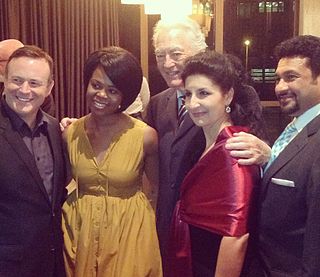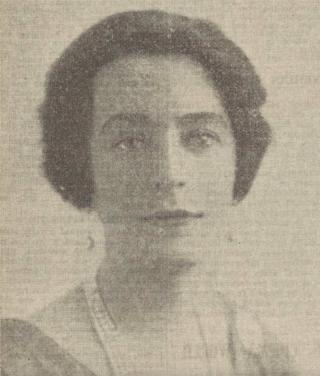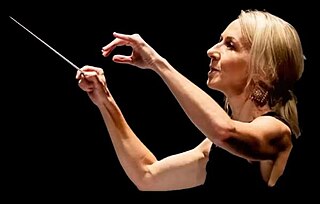
Opera Australia is the principal opera company in Australia. Based in Sydney, New South Wales, its performance season at the Sydney Opera House accompanied by the Opera Australia Orchestra runs for approximately eight months of the year, with the remainder of its time spent at the Arts Centre Melbourne, where it is accompanied by Orchestra Victoria. In 2004, the company gave 226 performances in its subscription seasons in Sydney and Melbourne, Victoria, attended by more than 294,000 people.

Richard Alan Bonynge is an Australian conductor and pianist. He is the widower of Australian dramatic coloratura soprano Dame Joan Sutherland. Bonynge conducted virtually all of Sutherland's operatic performances from 1962 until her retirement in 1990.
The Australian Ballet (TAB) is the largest classical ballet company in Australia. It was founded by J. C. Williamson Theatres Ltd and the Australian Elizabethan Theatre Trust in 1962, with the English-born dancer, teacher, repetiteur and director Dame Peggy van Praagh as founding artistic director. Today, it is recognised as one of the world's major international ballet companies and performs upwards of 150 performances a year.
The Green Room Awards are peer awards which recognise excellence in Cabaret, Dance, Theatre Companies, Independent Theatre, Musical Theatre, Contemporary and Experimental Performance and Opera in Melbourne.

The Princess Theatre, originally Princess's Theatre, is a 1452-seat theatre in Melbourne, Victoria, Australia. Established in 1854 and rebuilt in 1886 to a design by noted Melbourne architect William Pitt, it is the oldest surviving entertainment site on mainland Australia. Built in an elaborate Second Empire style, it reflects the opulence of the "Marvellous Melbourne" boom period, and had a number of innovative features, including state of the art electric stage lighting and the world's first sliding ceiling, which was rolled back on warm nights to give the effect of an open-air theatre.

Sir William Ian Potter, known as Ian Potter, was an Australian stockbroker, businessman and philanthropist. Potter was knighted in 1962. The Ian Potter Foundation, which he established in 1964, has made grants to research institutes, charities, universities and arts organisations. Since 1993, the Ian Potter Cultural Trust has awarded grants to individuals in the arts.

Theatre of Australia refers to the history of the live performing arts in Australia: performed, written or produced by Australians.
The Victoria State Opera (VSO), based in Melbourne, Australia, was founded in Melbourne in 1962. The company, founded by Leonard Spira, was a move into grand opera by the then amateur Gilbert and Sullivan-oriented Victorian Light Opera Co. The name changed to the Victorian Opera Company in 1964 in a move to enable the company to perform a broader repertoire.
Orchestra Victoria is a full-time salaried orchestra based in Melbourne, Australia, and wholly owned subsidiary of the Australian Ballet. Founded in 1969, the orchestra is now a principal performance partner for the Australian Ballet, Opera Australia, and larger productions of Victorian Opera.
The Opera Australia Orchestra is a full-time salaried orchestra, and a wholly owned subsidiary of Opera Australia. It is one of three salaried orchestras in Sydney, along with the Sydney Symphony Orchestra and the Australian Chamber Orchestra. The OAO performs almost exclusively in the Opera House Orchestra pit of the Joan Sutherland Theatre.

Gertrude Emily Johnson was an Australian coloratura soprano and founder of the National Theatre Movement in Melbourne.
Stefan Hermann Haag OBE was an Austrian-Australian singer; opera, theatre and television director and producer; lighting and set designer; and arts administrator. He was described as a “complete man of the theatre”.
Joseph Mozart Post was an Australian conductor and music administrator. He made an unrivalled contribution to the development of opera-conducting in Australia and was, in Roger Covell's words, the 'first Australian-born musician to excel in this genre'. As an orchestral conductor, he was judged a 'good all-round man': he was well regarded for his enthusiasm, clarity and economy of gesture, but he was not associated with inspiring or challenging musicianship. Nonetheless, his ability to take over conducting assignments at very short notice became legendary and he was often greeted with 'rave' reviews.
Tessitura is an enterprise application used by performing arts and cultural organisations to manage their activities in ticketing, fundraising, customer relationship management, and marketing. It refers to itself as "arts enterprise software."

Hélène Kirsova was a Danish prima ballerina, choreographer and ballet teacher and is noted as the founder of the first professional ballet company in Australia. She trained in Paris with former Sergei Diaghilev ballet dancers and choreographers. She then performed in companies run by Léo Staats and Ida Rubinstein before in 1931 becoming a soloist with Les Ballets Russes de Monte Carlo, dancing for several years in Europe and North America. In 1936, as a principal dancer, she joined René Blum's Les Ballets de Monte-Carlo in which she scored a singular success in London. Later that year she joined Colonel Wassily de Basil's Monte Carlo Russian Ballet as prima ballerina on an extensive tour of Australia and New Zealand where she was fêted by critics and audiences. She remained in Australia, started a ballet school in Sydney, and in 1941 formed the Kirsova Ballet. Despite wartime restrictions she directed the company for several years before retiring in 1948. She has been described as the "Godmother" of Australian ballet.
Carolyn Narelle Watson is an Australian conductor.

Brian James Stacey, was an Australian conductor who started his career with the Queensland Ballet, the Australian Ballet, and Victoria State Opera, latterly becoming known for his work in Australian musical theatre but continuing his cross-genre career to the end of his life.
Warwick Olney Fyfe is an Australian operatic heldenbaritone who has an international career. Winner of the Helpmann Award for Best Male in an Operatic Feature Role for his performance as Alberich in Opera Australia's 2013 Bi-Centenary Cycles of Der Ring des Nibelungen at the State Theatre in Melbourne. In August 2017 a career highlight was singing Klingsor in a concert performance of Richard Wagner's Parsifal starring Jonas Kaufmann with Opera Australia at the Sydney Opera House.

Vanessa Scammell is an Australian pianist and conductor in the field of ballet, musical theatre, concert, and opera.
The Kirsova Ballet was the first professional Australian ballet company. It was founded by prima ballerina Hélène Kirsova in 1941. Initially the leading performers were dancers who had stayed in Australia following the 1938/1939 tour of the Covent Garden Russian Ballet, but they were supported by talented young Australian dancers promoted from Kirsova's ballet school in Sydney. These local performers soon led the troupe and appeared in several seasons in Sydney, Melbourne, Adelaide and Brisbane. The company also supported Australian composers, musicians, artists and designers in producing new ballets choreographed by Kirsova. Struggling under wartime restrictions, unable to tour abroad, and later suffering creative differences with the country's main theatre owners, the company's prominence was brief. It closed in 1945 having been the pioneer of a genuine Australian ballet tradition. Its influence on Australian ballet was significant.








